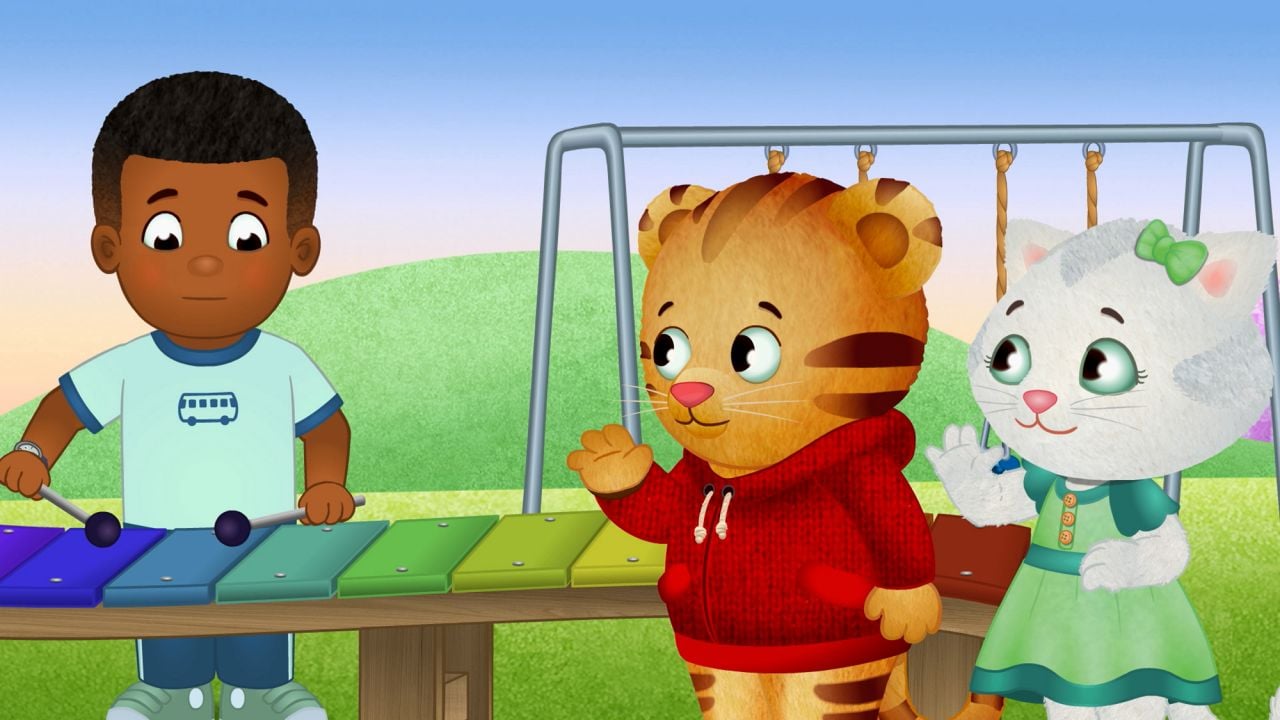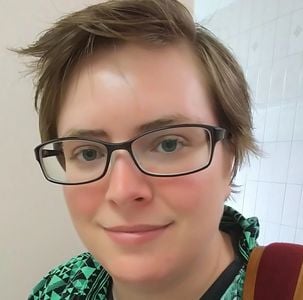Brain’s explanation is sensitive and accepting, asking George to put himself in an autistic person's shoes and imagine what it would be like. Brain tells George to imagine that he had crash-landed on an alien planet, one where everyone else behaved in ways he didn’t understand - they talked too loud, used idioms that didn’t make sense, and did things he found funny that weren’t meant to be. Brain goes on to explain that as George tried to learn about this planet, he might “find one thing that captures your attention and study just that,” and hopefully the people on the planet would begin to understand him better. The imaginary sequence shows that the inhabitants of the alien planet have learned to speak quieter to accommodate George, while George has learned some of their idioms and social customs.
With his new understanding, George goes to visit the community center again, leaving his puppet at home and instead taking a book on trains to share with Carl. The two become friends and at the end of the episode are hanging out at George’s home drawing together.
Brain’s explanation of autism was seen as wonderful by many in the autistic community because it expresses empathy towards autistic children and introduces other kids to the concept without pathologizing what being autistic means. In Brain’s scenario, there is nothing “wrong” with the person who has crash-landed on another planet. They are simply different. So the clashes that happen between them and other people are no more than clashes between two different cultures, where both bear responsibility for misunderstandings and learning about one another. This is the way that many autistic people have expressed that they wish for others to understand autism, so found it hopeful to be portrayed this way in a beloved show watched by millions of children.
After his introduction episode, Carl became a regularly recurring character in the series, where he is always welcomed and genuinely included with the other kids in Elmwood.
-
Pablo from Pablo (2017)
Pablo is the titular character from a British children’s show that first aired in 2017 and is available to watch on Netflix Kids. It follows the world of minimally speaking 5-year-old Pablo’s vivid imagination, transitioning from real-world scenes of Pablo encountering various new experiences to his colorful cartoon ‘Art World’, where he meets his six animal friends and they learn about the world together. Each of Pablo’s imaginary animal friends represents a different aspect of Pablo’s personality and other common autistic characteristics. For example, Mouse is organized and hates loud noises, Tang the orangutan is energetic and impulsive and has trouble reading social cues, Llama uses echolalia, and Draff the giraffe uses precise language and loves explaining things on the many topics he is knowledgeable about. Pablo learns from each of his friends about life and himself, as well as teaching and helping them out from time to time.
The most notable aspect of the series is that all the main characters - Pablo and his animal friends - are voiced by autistic actors, while the writing team for the series is also all autistic. This has led to Pablo being an incredibly positive and authentic representation of autism, showing how autistic children think about and approach situations and what truly helpful strategies can be used to cope with different challenging areas of life.
Some of the challenges that Pablo encounters include going to a loud birthday party, strange new smells in the house, itchy clothes, new crayons that are the wrong shape and colors, and a bus that isn’t on time. Pablo goes into his Art World when he is faced with these stressful situations and his animal friends can relate to different aspects of what he is feeling, helping him work through his emotions. In the end, Pablo figures out how to approach the different situations in ways that work best for him, such as deciding he does not want to go to the birthday party but would still like to give his friend her present outside the house. Pablo celebrates difference, acceptance, and natural autistic ways of being.
-
Julia from Sesame Street (2017)
Julia was introduced as the first autistic character to Sesame Street, a fun-loving muppet with bright red hair. Sesame Street worked with many different individuals and organizations in creating Julia’s character, including the autistic-led organization the Autistic Self-Advocacy Network (ASAN). Sesame Street’s choice to make their debut autistic character a young girl has been praised by many since there is still a large gap in understanding and representation of autistic girls and women. Julia is minimally speaking and is included and accepted by all the residents of Sesame Street.
Julia is first introduced when she is playing with Elmo and Abby and meets Big Bird for the first time. Big Bird is confused by some of Julia’s behavior but the others explain to him that she is autistic, so she does some things differently but she also loves to play and be with her friends. Big Bird suggests they play tag and Julia begins flapping her hands and bouncing while chasing everyone. The others say she’s invented a new game called “boing tag” and that it is a lot of fun. Big Bird understands that even though Julia might play in different ways, she brings a lot of fun and new ideas to their friendships. When Julia becomes upset at the sound of a siren, the others explain again to Big Bird that even though he thought “it wasn’t that loud,” it was to her because her ears are really sensitive. Big Bird then reflects on how everyone is different. After Julia has calmed down and joined them to play again, Big Bird tells her that something they have in common is that they both like to flap.
Julia is accepted for who she is on Sesame Street and Big Bird learns to understand the value that different types of people can bring to friendships. Many viewers in the autistic community were excited to see Julia’s hand-flapping being embraced positively, alongside her different ways of communicating and playing. Video clips and episodes with Julia’s character are available to watch on the official Sesame Street YouTube channel.
-
Renee from Pixar’s Loop (2020)
Renee is a 13-year-old Black girl in the Pixar short film Loop, released as part of a series of shorts on Disney+ in January 2020. The film tells the story of a young boy, Marcus, who is assigned to be Renee’s buddy on a canoeing trip at summer camp. Renee is non-speaking and at first, Marcus is unsure how to connect with her, but as their trip progresses, Marcus starts to see the world through her eyes, such as when she wants to brush her arms against a collection of reeds on the water. Renee delights in playing a particular ringtone on her phone repeatedly and Marcus takes her to a tunnel where she can hear the sound echo. However, when a speedboat races by, Renee becomes overwhelmed and paddles out of the tunnel, where the canoe crashes on a bank. Renee hides underneath the canoe and Marcus waits patiently for her to calm down, offering her a reed. The two connect again and continue their trip.
Loop is a short but impactful film about understanding and communicating with a non-speaking autistic girl in a way that looks at the world from her point of view. Several scenes in the short are depicted from Renne’s perspective so that the viewer can also understand how she sees things. During the creation of the film, autistic people from ASAN were brought in as consultants on the story. In interviews about the process, the animators explained how their assumptions of how the world looked from an autistic person’s point of view were incorrect. The consultants pointed to storyboards and scenes as accurate to their experiences that the animators did not expect. In the end, the creative team was able to have much more authentic portrayals by consulting autistic people themselves. In addition to having autistic consultants in the writing process, Madison Bandy, a nonspeaking autistic woman, voices Renee’s character.
Loop is a powerful example of how having authentic representation within the creative process, from writing to acting, creates better narratives for the autism community. The film has also been praised for depicting a young Black girl on the spectrum, in a media landscape where autism is still overwhelmingly depicted as only diagnosed among young white boys.
-
AJ Gadgets from Hero Elementary (2020)
Hero Elementary is a children’s cartoon, available to view on the official PBS KIDS YouTube channel, featuring a cast of characters with various superpowers. They attend ‘Hero Elementary’ where they learn to use their powers and face their fears. AJ Gadgets is a young autistic black boy who specializes in saving the day through the use of - you guessed it - gadgets. He can also project his thoughts for others to see.
AJ’s autistic characteristics show up in several ways throughout the series, such as his dislike of wearing wet clothes, flapping his hands when he’s distressed, wearing headphones to block out loud noises, and taking things literally. His character has been celebrated as part of the ever-increasing trend of showing characters with disabilities in children’s cartoons, as well as depicting such characters with more racial diversity.
A unique facet of AJ’s character in the representation of autism is that he is neither the center character of a show about autism nor a ‘special guest star’ character who only shows up from time to time to teach the other children how to be more inclusive. He is a full-fledged main cast member, supported and included as a member of the team without any of his friends drawing overdue attention to his differences, thinking he is odd, or having to ‘learn a lesson’ around his character. Rather, AJ is accepted, included, and appreciated for exactly who he is, which for the most part is just another hero and friend.
- Max from Daniel Tiger’s Neighborhood (2021)
Daniel Tiger’s Neighborhood is a cartoon series based on The Neighborhood of Make-Believe from Mister Rogers Neighborhood, with full episodes available on the PBS KIDS’ YouTube channel. Daniel Tiger is the main character and interacts with his friends in the neighborhood learning different lessons that are summed up in short songs. In the episodes “Daniel Tiger’s New Friend Max” and “A New Friend at the Clock Factory,” he meets a young boy named Max who is autistic. Max is their preschool teacher’s nephew and is visiting for a while. The teacher explains that Max is autistic and does things a bit differently, showing the others that he uses tools like a weighted blanket and headphones to help him feel more secure.
The short song that sums up the theme of the episode is: “When a friend needs different things than you, there are some things you can do.” Daniel Tiger and his friends learn throughout the two episodes that Max may have different needs in some situations - not liking the loud bells and bright lights at the Clock Factory, for example - but that there are strategies they can use to be more inclusive towards him, such as having a ‘Quiet Chime Time’ where they ring a small bell and dim the lights instead.
Max is planned to be a recurring character in the show going forward, along with his big sister Amira. Max’s character is voiced by an autistic teenager, eighth-grader Israel Thomas-Bruce. The creators of the series are excited to help autistic children feel more represented in the shows that they watch, as well as teach neurotypical children how to be inclusive towards their friends who have different needs.
Do you have a favorite character to share that I have missed from my list?







